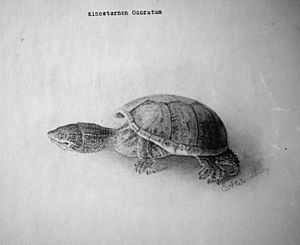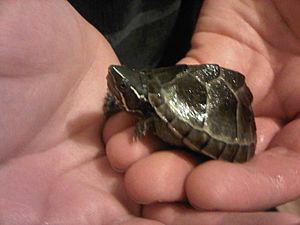Common musk turtle facts for kids
Quick facts for kids Common musk turtle |
|
|---|---|
 |
|
| Conservation status | |
| Scientific classification | |
| Genus: |
Sternotherus
|
| Species: |
odoratus
|
The Sternotherus odoratus is a small type of turtle found in southeastern Canada and much of the Eastern United States. It's often called the common musk turtle, eastern musk turtle, or stinkpot. It gets the name "stinkpot" because it can release a stinky, musky smell from special glands near its shell. This smell helps scare away animals that might try to eat it. This turtle belongs to the same family as mud turtles.
Contents
What Does It Look Like?
The stinkpot turtle is usually black, grey, or brown. It has a shell that is quite dome-shaped, like a helmet. These turtles are small, growing to about 5 to 14 centimeters (2 to 5.5 inches) long. They usually weigh around 600 grams (1.3 pounds).
They have a long neck and short legs. You can often spot them by the yellow lines on their neck, especially when they are swimming. Male turtles have longer tails than females. They also have a small spike at the end of their tail. Females are usually bigger than males.
Their head looks a bit like a triangle, with a pointy snout and a sharp beak. They have yellow-green stripes that go from their nose to their neck. Small, whisker-like parts called barbels are found on their chin and throat. Their bottom shell, called the plastron, is quite small. This means their legs are not very protected. Sometimes, Algae can grow on their shells. They even have tiny bumps on their tongues that help them breathe underwater!
How Does It Behave?
The eastern musk turtle spends almost all its time in the water. It prefers shallow waters that have lots of plants and move slowly, like creeks or ponds. They usually only come onto land when a female needs to lay eggs. Sometimes, they also come out to warm up in the sun.
These turtles are good climbers. They can climb up sloping tree trunks or branches that are partly in the water. They can go as high as 2 meters (6.5 feet) above the water! They are not very good swimmers. You will often see them walking along the bottom of swamps, marshes, or rivers. Their main defense is to release a musky smell. If they feel bothered, a wild stinkpot might bite. Since their neck can stretch very far, you need to be careful if you ever handle one.
What Do They Eat?
The stinkpot turtle is a carnivore, meaning it eats meat. They enjoy a variety of water creatures. This includes crayfish, freshwater clams, snails, and different kinds of insects. They also eat fish, tadpoles, and dead animals. Young turtles eat more meat than adult turtles. As they get older, they might start to eat some water plants too.
Where Do They Live?
S. odoratus turtles live in many different wetland areas. They especially like shallow waters that have a slow current and a muddy bottom. Even though they spend most of their time in water, they can also climb. You might see them warming themselves on fallen trees or logs. These fallen trees are very important for turtles to bask on.
Like all turtles, stinkpots need to lay their eggs on land. Building homes along shorelines can harm their nesting spots. You might also see these turtles on roads, especially during nesting season or after heavy rain. Sadly, they can get hit by cars. In winter, they hibernate by burying themselves in the mud or hiding in muskrat homes.
How Do They Reproduce?
Eastern musk turtles usually breed in the spring. Female turtles lay about 2 to 9 eggs. Their eggs are oval-shaped and have a hard shell. They often lay them in a shallow hole or under things like logs near the water. Sometimes, many females will lay their eggs in the same spot! For example, 16 nests were once found under a single log.
The eggs hatch in late summer or early fall. This takes about 100 to 150 days. Young turtles are usually less than 2.5 centimeters (1 inch) long. Their shells are very bumpy when they are young. As they grow older, their shells become smooth and dome-shaped. Many eggs are eaten by predators, which is common for many turtle species. These turtles can live for a long time. Some have been known to live over 50 years in captivity!
Where Are They Found?
The common musk turtle lives in southern Ontario and southern Quebec in Canada. In the Eastern United States, they are found from southern Maine down to Florida. They also live west to central Texas. There is also a separate group of them in central Wisconsin.
Naming the Turtle
The common musk turtle was first described by a French scientist named Pierre André Latreille in 1801. He found a specimen near Charleston, South Carolina. At first, he named it Testudo odorata. Later, in 1825, another scientist named John Edward Gray created a new group called Sternotherus for musk turtles. That's when it got its current name, Sternotherus odoratus. There has been some discussion among scientists about whether musk turtles and mud turtles should be in the same group.
Conservation Status
The common musk turtle is generally common in most places it lives. However, its numbers have gone down in some areas. This is often because human activities have harmed their wetland homes. For example, it is listed as a threatened species in the state of Iowa. In Canada, it is considered a species at risk and is protected by law. In Ontario, it is also protected under the endangered species act. In these areas, only wetlands that have not been changed much by humans have many of these turtles. Female turtles getting hit by cars on roads is one problem caused by human development.
Keeping Them as Pets
Because of their small size, common musk turtles can be a good choice for a pet turtle. They are often caught in the wild for pets, but many are also bred in captivity. (In the United States, there are rules against selling turtles smaller than 10 centimeters (4 inches) as pets.)
These turtles will eat commercial turtle pellets, algae wafers, and various insects. They like crickets, snails, mealworms, and earthworms. It's important to give them a variety of foods for them to stay healthy. Just feeding them pellets is not enough. They also need extra calcium, which can be given as powder or a cuttle bone. Some musk turtles also like to eat aquatic plants. Like most turtles, they need special ultraviolet (UVA and UVB) light to stay healthy, even though they don't bask in the sun very often. You should still provide a warm spot for them to bask if they want to.
Images for kids
See also
 In Spanish: Tortuga almizclada para niños
In Spanish: Tortuga almizclada para niños









